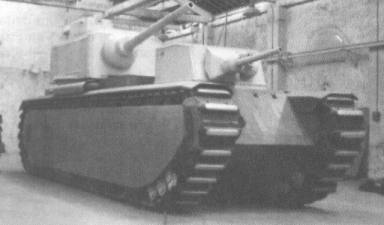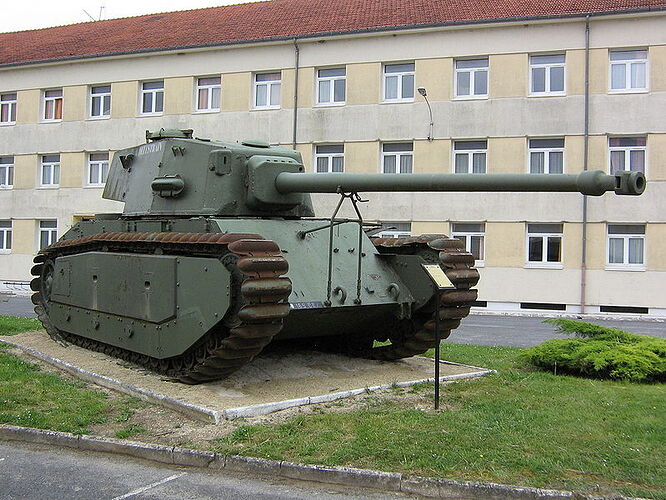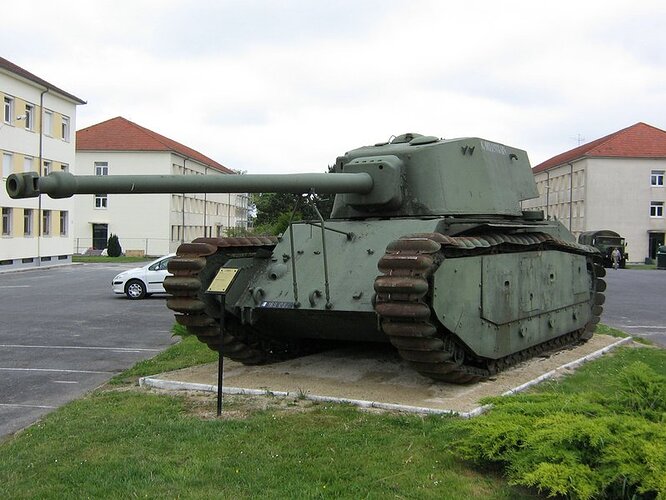Thanks Panzerknacker, I hadn’t read about this one either! Nice!
Somehow I don’t think it would have been quite as effective as they would hope for, other than the psychological effect.
It seems like a huge target for artillery, and knowing the engines of that time period, it probably wouldn’t have gone very fast either…
Still, a driving fortress…
It was specifically meant for assaulting heavily fortified positions, and though speed wasnt important the French planned to replace the 2C´s due to age. Only 10 were built, one converted to mount a 155mm howitzer (though only 6 seems to have been accounted for in 1940, the remainder migth have been scrapped). 12 so called F1´s of the same size and suitable land-battleship apperance were to be acquired as replacements.
A picture exists of a mock up:

That’s freakin’ awesome!! It looks like something out of a H.G Wells novel.
Thanks Panzerknacker, I hadn’t read about this one either! Nice!
You re welcome, the french had some interesting technical solutions for their tanks, maybe we need a French armor topic.
Not a bad idea. I’ve had some questions on a French heavy tank that started development before the Fall, and was worked on continuously in secret under the Vichy Army by disgruntled officers. The Armistice forbid any French tank development…
From what I’ve seen, it rivaled a Tiger but was a bit too outmoded to see postwar deployment so it was abandoned with maybe a few prototypes although it later contributed to French tanks such as the AMX-30…
You ever hear of this project?
I wouldn’t mind learning about that topic. Sadly, I’d be more of a reader than a poster. Yeah I know, let other people do all the work.:rolleyes:
Selbstfahrlafette s.I.G.33/2 auf Bergepanzer 38 (t)

This AFV was the result of mounting a schwere Infanterie Geschutz ( heavy infantry support cannon) over an Bergepanzer 38 chassis.
Internal capacity for ammunition was merely 15 round with separate charge. Elevation varied from -2º up to 45º. Azimuth only 7 degrees at left and right.
The armor was reduced in the sides, from 20 to 12mm, probably to save some weight. Frontal plate was 30mm thick.
Automotive characteristics were the same as all late czech 38 (t) designs, with a 6 cilinders gasoline 150 hp engine and leaf spring suspensison with 2 bogies per side. Weight around 11,5 tons.
Despite the good aspect of this sturmgeschutz it did not manage to enter in service. Probably due the extreme cramped combat room. A single prototyte assembled by the Bohemische und Moravische Motorenwerke ( BMM Prague) in fall 1944.
Ha! Thank you. But I got it on the Googles before I read this…
Still a fascinating tank.
Despite the good aspect of this sturmgeschutz it did not manage to enter in service
Err, :mrgreen: my mistake the thing is not a sturmgeschutz ( assault gun) but a selbstfahrlaffete ( self propelled gun or motor gun carriage in the US)
Other photo of the s.I.G 33/b auf Bergepanzer 38 (t), cute, really cute.

Agreed… very ‘cute’… the Care Bear of the panzer world… However, it’s probably a good thing it never had to see action, that 15 round magazine capacity, & poor armour protection would have rendered it virtually ineffective before it began.
However, it’s probably a good thing it never had to see action, that 15 round magazine capacity, & poor armour protection would have rendered it virtually ineffective before it began.
Agreed, for direct fire support as the sturmgeschuts it would be short lived in the east front battlefield, maybe it had some used as indirect support vehicle, even the 15 cm s.I.G is not a long range gun, I think maximum range varied between 4,6 to 6 km.

Hello gentlemen.
A Flak36 8.8cm carried upon a Panzer IV cassis - both photos are from a series of pictures shot in 1945 on a tank yard in the CZ.
I think it is more a field modification, than a real ‘project or prototype’ - althought more than one vehicle must have been equipped with that gun [note the tanks tracks in the two pictures.]


Nice, at first glance it looks like the “versuchsflakwagen” but is not, the VFW had FAMO interleaved rollenlaufwerk and this had the standar wheels with leaf springs.
Err, my mistake the thing is not a sturmgeschutz ( assault gun) but a selbstfahrlaffete ( self propelled gun or motor gun carriage in the US)
Other photo of the s.I.G 33/b auf Bergepanzer 38 (t), cute, really cute.
Therein probably lies the clue to how it was intended to used. The only direct fire SFl´s I can think of were those with AT guns.
And aren´t they cute, all the 38(t) Hetzer deriatives 
True, but I think sometimes it depend more in the tactical situation than the armament. Remember that both sturmgeschutz III and the early panzer IV with 75 mm howitzer had aiming devices for indirect fire ( despite the fact the gun elevation wasnt great thus limiting the range)
Some direct support 15 howitzer armed panzers were developed, like the s.I.G 33 over a Panzer III chassis with fully enclosed armor and the Brümbar.
I ve seen some footage of german troops fightings in Kharkov in 1943 and they used everything, stugs, panzers and even the Marder tankhunter firing at point blank ranges against bulidings ( I guess the casualty rate between the crews of this late vehicle were a bit high)
Some interesting designs. You have to wonder how much this many varied designs slowed down actual develpment of a working vehicle.
I’m actually somewhat surprised that none of these “Landship” designs were used by either faction. Were the Cons outweighing the Pros so much?
Some interesting designs. You have to wonder how much this many varied designs slowed down actual develpment of a working vehicle.
The reply to that questions is simple…A LOT !!
Specially idiotic are the designs for a movable and dismountable howitzer ( Waffenträgers) called “Heuschrecke” ( grasshoper, check the earlier pages for info about it) not to mention the futility of some prototypes as the Maus and the use of valuable chassis ( Panther, Tiger, Tiger II) for other duties.
I’m actually somewhat surprised that none of these “Landship” designs were used by either faction. Were the Cons outweighing the Pros so much
Well I will just said one thing, the Maus used 5 tons of copper for his electric engines/generators, that is the same weight of the Panzer I…:rolleyes:, and is a metal the Deutschland almost have not supplies in 1944, remember most of the cartrigde cases were made of laquered steel, not copper or brass ( wich incidentally is a mix of copper and zinc).
I thought there was some speculation that a Maus did see combat and made a final stand as the Soviets overran the testing range?
Other landship for the record :mrgreen:
K-Wagen:

[FONT=Verdana]In June 1917, before the first A7V:s were even completed, the German War Ministry ordered the construction of a new colossal super-tank, the biggest tank ever designed: the K-Wagen. (K standing for Kolossal) The K-Wagen was thought as a enormous moving fortress bristling with guns and MGs, to be used in break-through situations. The weight was some 150 tons, and it would be powered only by two small 200 HP motors. (Later on these two tiny motors were switched for two 650 HP motors.) The enormous weight of the vehicle of course made it impossible to move any longer distances, so it was to be transported by rail in four parts of some 30 tons each, only to be put together behind the front line, at the point were it was to be employed. The K-Wagen was also supposed to have a trench crossing capacity of some 4 meters, and no less than four 77mm field howitzers . The design was done by Vollmer. [/FONT]
[FONT=Verdana][/FONT]
[FONT=Verdana] [/FONT]
[/FONT]
[FONT=Verdana]Almost from the very beginning of the project sceptical voices was heard. The sheer size of the vehicle made it difficult to produce, as no standard components or techniques could be employed. So it was decided that the tank was to be built by companies with experience from building bridges and the tracks came from power shovel construction. Soon it was also discovered that the tank was too heavy, so the length was reduced to 13 meters, which at least cut the weight with some 30 tons. The original order was for ten vehicles. The weight was some 120 tons! It has been called “completely nonsensical” and the Army actively sought to prevent the order as the type was seen by the military as hugely impractical and a complete waste of scarce resources, but two prototypes were actually under construction when the war ended - one was nearly finished. People doubting the whole idea were silenced by being told that von Hindenburg himself wished it to be built.
The Großkampfwagen or “K-Wagen” had a crew of 27: a commander, two drivers, a signaler, an artillery officer, 12 cannoneers, eight machine gunners and two mechanics. In the beginning of the project it was proposed to incorporate a flamethrower but this was later rejected. The commander could give orders to the crew by means of electric lights: fire control was comparable to that of a destroyer, so the Germans saw the vehicle as a veritable “landship”. The drivers would have had to steer the vehicle blindly, directed by the commander.
The type was even bulkier than the Ferdinand Porsche-designed World War II era Maus and therefore the largest tank ever built. It would never become operational however as under the armistice conditions Germany was forbidden to possess tanks and all hulks were scrapped. In 1942 Hitler had a full scale wooden mock-up built for comparison with his own examples of tank gigantomania
[/FONT]



